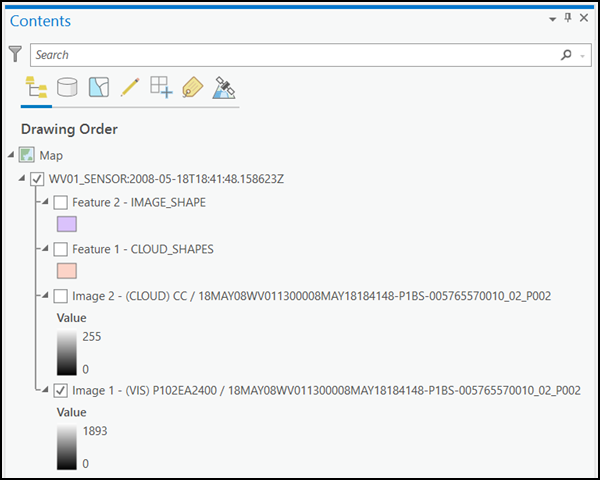The National Imagery Transmission Format (NITF) was created to be a transportable format for imagery that is needed and disseminated within the United States Department of Defense (DoD) and Intelligence Community (IC). It is designed as a container format that has the information necessary for the exploitation of the imagery—all contained in one file. This includes image metadata, contextual information to understand the contents of the NITF file, and handling instructions relative to classification and distribution.
A NITF file can contain several types of data that include important information components. In addition to the imagery, which can have several segments, other associated data can include shapefiles with extents, observations, image quality data and layers, annotations, callouts, and more.
Note:
Data supplied as part of humanitarian efforts that are supported by the DoD and IC are often delivered as NITF files.
The primary reference document for the NITF 2.1 file format standard is MIL-STD-2500C1. It is recommended that you become familiar with the MIL-STD-2500C document and the appropriate implementation specifications when you use a National Geospatial-Intelligence Agency (NGA) or DoD imagery product that is delivered as an NITF file.
Imagery products have unique implementation standards, such as the commercial imagery standard1.
For United States partners, especially countries included in the North Atlantic Treaty Organization (NATO), the NATO Secondary Image Format (NSIF)1 is also supported. While NSIF and MIL-STD-2500C standards are very similar, it is important to note that NATO countries have their own implementation standards when building imagery products.
NITF support
ArcGIS Pro supports access to the image support data contained in the NITF file. This allows you to process and visualize the image data appropriately and take advantage of the metadata to help manage data, projects, workflows, and applications. Multisegment images are supported, allowing them to be indexed, processed, and displayed to preserve the relationships built into each NITF source product. A layer is created for each image sublayer and listed in the Contents pane.
When an NITF file is opened, ArcGIS Pro builds an NITF layer to organize the contents of the NITF file into related data items. The data items provide you with a structured look at the file contents. This is expressed as an NITF layer, with each data type represented as NITF sublayers in which each sublayer, such as an image sublayer, in the NITF file can be activated and managed separately.
By default, the NITF layer is listed in the Contents pane and is named based on the value in the NITF FTITLE field, which can be up to 80 characters. If the FTITLE field is not available, the label switches to the NITF file name.
Each image sublayer is labeled with a three-part label showing the ICAT, IID1, and IID2 fields. Each feature sublayer is labeled showing the SHAPE_USE field found in the Data Extension Segment (DES). All image and feature sublayers in the NITF file are supported and listed in the Contents pane.

NITF metadata
There are several ways the metadata in the NITF file is used. The primary use is for geopositioning of the imagery and proper image processing in the display pipeline. There are two additional capabilities in the user interface to assist when there are multiple image sublayers in the NITF file. The first capability is the way an NITF layer appears in the Contents pane. The second capability is the informational aspect of the metadata that is shown in the appropriate Image Support Data (ISD) portion of the properties dialog box.
Much of the ISD, stored as Tagged Records Extensions (TRE) in the NITF file, is used for display and analysis purposes. The details of which TREs are used and how they are used are described in the next section, including other metadata records such as the NITF file Data Extension Segments (DES).
Geopositioning NITF image sublayers
NITF files can contain multiple sources of map transformation metadata to properly position the imagery with respect to the earth's surface. It is important to know the order and precedence of use to understand the quality of positioning. The application precedence in ArcGIS Pro of the coordinate data in the NITF file is listed below.
- CSM (Community Sensor Models)—The primary map information for the file. This is used if the CSM is available and the appropriate ISD is present.
- SENSRB—Predominately used for single frame full-motion video (FMV) files if the appropriate ISD is present, such as sensor attitude metadata.
- RPC00A and RPC00B—Rational polynomial coefficient information is used if CSM or SENSRB information is not available.
- GEOSDE—Map information (if available) is imported from MAPLOB, PRJPSB, and GEOPSB TREs, and tie point and pixel sizes are created in the specified projection. If the projection is not supported, this information is considered invalid and the IGEOLO georeferencing method is attempted.
Note:
If available, tie point and pixel size are imported into a geographic coordinate system from the GEOLOB and GEOPSB TREs.
- IGEOLO—The NITF image subheader containing coordinate data. If the coordinate data is valid, the tie point and pixel size are computed for the image. Otherwise, an affine map transformation is used to determine georeferencing for the image.
Note:
IGEOLO coordinates are not considered accurate and are used for approximate location in discovery indexing.
- ICHIPB—Used to perform mensuration and to calculate geopositions of features on image chips.
Note:
Locational tags not currently supported include RSM, ILOC, and BLOCKA.
References1
For information regarding NITF standards documents, route your request to: NCDRD-NCDDD-Custodian@nga.mil.